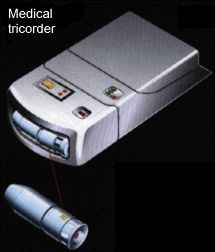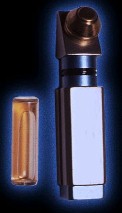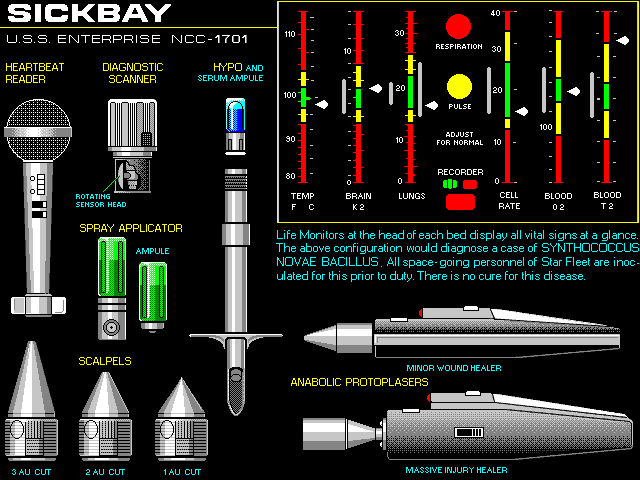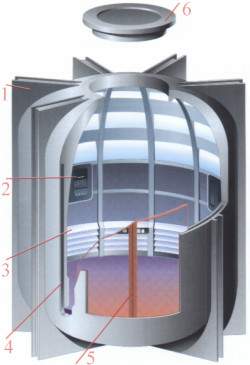Medkits
Medical personnel on Away missions or other assignments away from sickbay facilities are frequently issued any of a variety of medkits. These portable equipment packages typically include a medical tricorder, field hypospray, respirator, defib module, sample kit and a selection of bandages and drugs for field use.
Medical Tricorder

The
Medical Tricorder (MT) consists of a standard tricorder with a specialized
medical peripheral (MP) device. The MP in conjunction with the tricorder,
with both active and passive scans can provide detailed diagnostic readings
of total body mechanical processes, organ system function, disease organism
infiltration and body electromagnetic conditions. Combined readings can
synthesize images and numerical readouts to aid sickbay personnel in identifying
biological antagonists and determining courses of treatment. In the field,
the tricorder can access an updatable file of known medical conditions
for most humanoid types and many of DNA based Non - humanoids. When operating
onboard ship, the tricorder can draw upon the entire medical Database of
the central ship computer.
.
Hypospray

Subcutaneous
and intravenous administration of many types of medication is accomplished
with the hypospray. This device employs a pinpoint high-pressure low volume
microscopic Aero-suspension stream, which permits low-viscosity medication
to be administered through the epidermis without mechanical penetration.
Certain types of medications can be formulated for a somewhat wider spray
pattern, resulting in lesser penetration into the epidermis, but yielding
a higher rate of absorption due to the greater skin area exposed to the
drug. Standard hyposprays are designed to accept a standard medication
vial, which can be changed as required. Field hyposprays are normally loaded
with an inert saline solution that serves as a vehicle fluid for any of
five user-selectable concentrated emergency medication ampules.
.
Facilities
.
The
Medical department, under the direction of the Chief Medical Officer, is
principally located in two sickbay facilities on Deck 12. The primary facility,
located on the port side of the ship, consists of two medical intensive-care
wards, an attached laboratory, the CMO's office, and a small nursery. The
second facility, located on the starboard side of Deck 12, is similar to
the primary sickbay but features two dedicated surgery suites, a physical
therapy facility, a nursery, and a null-gravity therapy ward. Adjacent
to the second facility is a dental care office and a full biohazard isolation
unit. These facilities provide the medical staff with an impressive complement
of tools with which to handle extraordinary range of medical problems for
both known and unknown species. Capabilities include a fully equipped medical
laboratory with advanced bio - assay and life form analysis hardware. Also
available are nano - therapy, genetic sequence and viro - therapeutic equipment.
Medical lab capabilities can be bolstered by employing the lab services
of one or more shipboard science departments. In a large scale medical
emergency situation, all three shuttle bays can be converted to medium
and intensive-care hospital facilities using quick deploy emergency hospital
modules. Additionally, lesser numbers of overflow patients can be handled
by conversion of guest quarters on decks 5 and 6 to medical intensive care
units.
Biobed
A
key element to the medical intensive-care unit is the biobed sensor and
support unit. An
orthopedically
designed hospital bed incorporates a basic array of biofunction sensors
that can be tied into a variety of remote medical instruments including
the tricorder. Also incorporated are
a
number of medical gas and fluid connect points for various devices, including
the surgical support frame.
Surgicle Support Frame
A
vital tool in nearly all of the surgical procedures is the surgical support
frame (SSF), or clamshell"
as
it is sometimes called. The SSF not only maintains a sterile environment
for most surgical rocedures, but also incorporates several vital diagnostic
and life support tools. These include a battery of bio-function sensors,
supplementing those provided by the biobed and by the overhead medical
equipment array. The SSF is capable of automated administration of
intravenous medication as well as cardiovascular support and emergency
defibrillation. A variety of surgical support frame types are available
for different procedures, as well as for different life form types. Most
biobeds are designed to accept surgical support frames. Surgical procedures
are accomplished at the primary biobed, located at the center of each sickbay
ward or surgical suite. Above this biobed is an overhead cluster
of diagnostic and biofunction sensors. This array also incorporates a low
level force field generator that can be used to reduce the chance of potentially
harmful microorganisms entering or leaving the biobed area. Note that this
force field is of a relatively limited utility and is not adequate to maintain
a totally sterile environment sufficient for surgical procedures or to
satisfy biohazard protocols.
.


2) Turbolifts have a voice-command interface, but there is also a manual interface (seen here).
3) The inertial damper-matrix in the bottom absorbes shocks and velocity changes.
4) The walls of a turbolift are very thin, but also very strong.
5) The doors of a turbolift are non-tranparent, because the turbo-shaft is boring to look at. The doors open automaticly when a person wants to get in or out, but they can be opened manually.
6) Emergency escape hatch, in case the turbolift gets stuck between two decks.